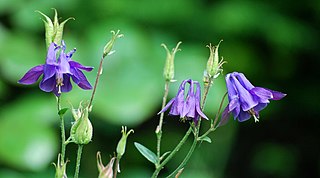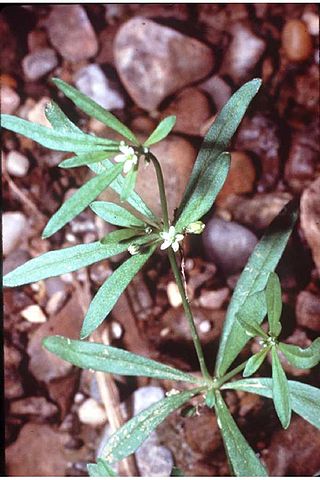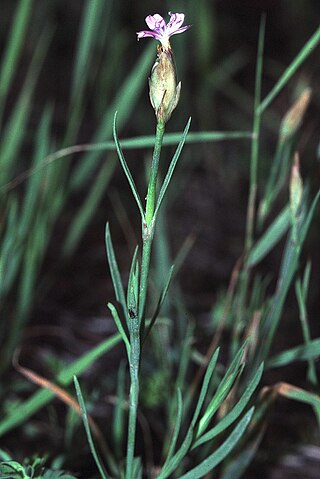
Aquilegia is a genus of about 130 species of perennial plants that are found in meadows, woodlands, and at higher elevations throughout the Northern Hemisphere, known for the spurred petals of their flowers.

Silene is a genus of flowering plants in the family Caryophyllaceae. Containing nearly 900 species, it is the largest genus in the family. Common names include campion and catchfly. Many Silene species are widely distributed, particularly in the northern hemisphere.

Caryophyllaceae, commonly called the pink family or carnation family, is a family of flowering plants. It is included in the dicotyledon order Caryophyllales in the APG III system, alongside 33 other families, including Amaranthaceae, Cactaceae, and Polygonaceae. It is a large family, with 81 genera and about 2,625 known species.

The Portulacaceae are a family of flowering plants, comprising 115 species in a single genus Portulaca. Formerly some 20 genera with about 500 species, were placed there, but it is now restricted to encompass only one genus, the other genera being placed elsewhere. The family has been recognised by most taxonomists, and is also known as the purslane family. It has a cosmopolitan distribution, with the highest diversity in semiarid regions of the Southern Hemisphere in Africa, Australia, and South America, but with a few species also extending north into Arctic regions. The family is very similar to the Caryophyllaceae, differing in the calyx, which has only two sepals.

Gypsophila is a genus of flowering plants in the carnation family, Caryophyllaceae. They are native to Eurasia, Africa, Australia, and the Pacific Islands. Turkey has a particularly high diversity of Gypsophila taxa, with about 35 endemic species. Some Gypsophila are introduced species in other regions.

Mentha longifolia, also known as horse mint, brookmint, fillymint or St. John's horsemint, is a species of plant in the family Lamiaceae. It is native to Europe excluding Britain and Ireland, western and central Asia, and northern and southern Africa.

Spergula is a genus of flowering plants in the family Caryophyllaceae. Their usual English name is spurry or spurrey. It includes 10 species native to portions of South America, Africa, and Eurasia. They are commonly found in grassland.

The Molluginaceae are a family of flowering plants recognized by several taxonomists. It was previously included in the larger family Aizoaceae. The APG III system of 2009 made no change in the status of the family as compared to the APG II system of 2003 and the APG system of 1998, apart from a reassignment of several genera, such as the placement of Corrigiola and Telephium into Caryophyllaceae, Corbichonia in Lophiocarpaceae, Microtea into Microteaceae and Limeum in Limeaceae, because the family was found to be widely polyphyletic in Caryophyllales. In addition Macarthuria was found not to be related to Limeum as previously thought and thus it was placed in Macarthuriaceae, and similarly species formerly placed in Hypertelis, apart from type species Hypertelis spergulacea, a true Molluginaceae, were found to belong elsewhere and were described as Kewa in the family Kewaceae, named for the Royal Botanic Gardens Kew. Molluginaceae is still assigned to the order Caryophyllales in the clade core eudicots, although the generic circumscription is difficult because Mollugo is not monophyletic.

Moenchia is a genus of plants in the family Caryophyllaceae with three species native to the Mediterranean region of southern Europe and naturalised in southern Africa and parts of North America and Australia. They are herbs, with an annual life span. They have slender roots and thin stems that are upright or ascending. Inflorescences are one- to three-flowered and terminally end the stems. The flowers are in spreading cymes or solitary, with bracts paired that are leaf like. Named after the 18th century German botanist Conrad Moench. A common name for the plants in this genus is upright chickweeds.

Sagina is a genus of 20–30 species of flowering plants in the family Caryophyllaceae. These are flowering herbs native to temperate regions of the Northern Hemisphere extending south to tropical mountain areas at high altitudes, reaching just south of the equator in Africa. They are small annual or perennial herbaceous plants, growing to 5–15 cm. The leaves are opposite, often in tight whorl-like clusters, simple linear, typically 5–20 mm long. The flowers are solitary or in small cymes, with four or five green sepals and an equal number of white petals; the petal size relative to the sepal size is useful in species identification. The fruit is a small capsule containing several seeds.

Scleranthus, the knawels, are a genus of herbaceous plants in the family Caryophyllaceae. It includes 12 species native to Europe, Siberia, western Asia, north Africa, Ethiopia, New Guinea, and Australia.

Caryophyllales is a diverse and heterogeneous order of flowering plants that includes the cacti, carnations, amaranths, ice plants, beets, and many carnivorous plants. Many members are succulent, having fleshy stems or leaves. The betalain pigments are unique in plants of this order and occur in all its families with the exception of Caryophyllaceae and Molluginaceae.

Flemingia is a genus of plants in the family Fabaceae. It is native sub-Saharan Africa, Yemen, tropical Asia, and Australasia. In Asia the species are distributed in Bhutan, Burma, China, India; Indonesia, Laos, Malaysia, Nepal, Pakistan, Papua New Guinea, Philippines, Sri Lanka, Taiwan, Thailand and Vietnam. The genus was erected in 1812.

Polycarpon is a genus of flowering plants in the family Caryophyllaceae. They are known generally as manyseeds. There are 7 species distributed in temperate and tropical regions around the world, including western North America, South America, Europe, Africa, and West, South, and Southeast Asia. These plants are low, matted annuals spreading slender stems along the ground or erect with many branches. The best-known species is perhaps Polycarpon tetraphyllum, which is native to southern Europe but is present in many other regions as an introduced species.
Euseius is a genus of mites in the Phytoseiidae family.

Illecebrum is a monotypic genus in the family Caryophyllaceae. It contains the single species Illecebrum verticillatum, which is a trailing annual plant native to Europe, with whorls of small white flowers borne in the axils of the paired leaves.
Telephium are a genus of flowering plants in the family Molluginaceae or Caryophyllaceae, found in Mediterranean parts of Europe, Africa, the Arabian Peninsula, and western Asia. They are annual or perennial herbs, sometimes becoming woody at their bases. Together with Corrigiola they form the tribe Corrigioleae.

Herniaria lusitanica subsp. berlengiana is an endangered subspecies of flowering plant in the family Caryophyllaceae. It is endemic to the Berlengas Archipelago, Portugal.

Petrorhagia prolifera is a species of flowering plant belonging to the family Caryophyllaceae.

















